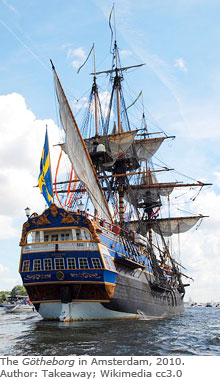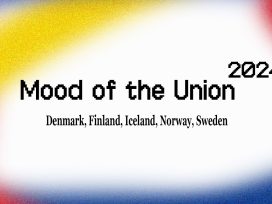In October 2005, the East India ship Götheborg set sail from “event city” Gothenburg to Shanghai. It was the culmination of a long process of reconstruction that had been accompanied by publicity stunts, angry opinion pieces and political and diplomatic interventions. Thousands of Gothenburgers gathered along the harbour to wave off the ship. Young people were engaged as volunteers, cultural workers blogged from on board and the city’s daily newspaper acted both as cheerleader and sponsor. The route would reconstruct the original route. This project, you see, got its meaning from its use of history.
The boat was a replica of an eighteenth-century ship built in Stockholm belonging to the East India Company, used primarily for trade with China. Around twenty years ago, a handful of idealists, marine archaeologists and adventurers began diving after it and started building the replica. In the mid-1990s, the adventure became too expensive and complicated and they looked for partners. But these “partners” had another agenda; their idea was to “benchmark” Gothenburg, a notion typical of the political belief at the time that “events” were equal to culture. The business world, meanwhile, wanted to use the ship as a way of breaking into the Chinese market. The project gobbled up resources and, in an attempt to arouse interest and to ensure the project got off the ground, a group of ambassadors wrote an opinion piece. “It is important to show that Sweden has a long history as a successful trading nation, via, among others, the East India Company,” they wrote.
Today, when Swedish companies are among the world-leaders in, for example, communications and transport, the East India ship is a concrete symbol representing international contacts and free trade. The picture of Sweden as a nation without a colonial past, but with a long history of international trade, is strengthened. Given the heavy, international competition, it is our job as representatives of Sweden to promote our country as an interesting business partner, and for that reason we actively support the East India ship project.
 This sums up the official picture of Götheborg, a picture that nevertheless hides central historical connections: European trade with China is indisputably connected with the colonialism that is denied by the ambassadors quoted above. Of course, China was not a colony of Sweden (or any other European nation) in the eighteenth century. But the East India Company’s success story (it is unknown what its profits were, since the accounts have disappeared, but everyone agrees that they were high) depended on their ability to take advantage of other countries’ colonies and the already existing trade. At the time, Sweden’s lack of colonies was viewed as a real disadvantage; today, the fact is used to promote Sweden’s image as neutral and peace-making.
This sums up the official picture of Götheborg, a picture that nevertheless hides central historical connections: European trade with China is indisputably connected with the colonialism that is denied by the ambassadors quoted above. Of course, China was not a colony of Sweden (or any other European nation) in the eighteenth century. But the East India Company’s success story (it is unknown what its profits were, since the accounts have disappeared, but everyone agrees that they were high) depended on their ability to take advantage of other countries’ colonies and the already existing trade. At the time, Sweden’s lack of colonies was viewed as a real disadvantage; today, the fact is used to promote Sweden’s image as neutral and peace-making.
Sweden did not actively distance itself from the colonization of far-off countries. On the other hand, Sweden was not particularly successful in its colonization efforts, perhaps because it was distracted by imperial ambitions in its own region, particularly the Baltic Sea. Yet there is a direct line between Sweden’s biggest colonization attempt and the East India Company.
In 1649, for example, the Swedish African Company obtained the right to trade slaves, ivory and gold in West Africa. The next year, building began on a trading fort on the Gold Coast in what is now Ghana. The small fortification, named Carolusborg after King Karl X Gustav, was soon lost to other colonizers and ended up as part of the British Gold Coast colony. Today, the fort, Cape Coast Castle in western Ghana, is a monument to the export of slaves that once took place here. In the permanent exhibition, Sweden’s role has not been covered up. Another example of Sweden’s failed colonial history is the Caribbean island of Saint-Barthélemy. A lesser known colonial project was Karl XII’s attempt to colonize Madagascar in exchange for giving the pirates there a sanctuary on Marstrand on the southwest coast of Sweden. One of the participants in this enterprise was Henrik König, who twenty years later started the East India Company with Henric Sahlgren and the Scotsman Colin Campbell.
Then, as now, one of the East India ships’ way stations was the Spanish city of Cádiz. If one wishes to portray the East India Company as unsullied by Europe’s colonial past, one does not discuss the reason for their doing so. The Chinese were not especially interested in trading with Europe, since they had most commodities already. What was interesting for them, however, was silver. The Sala silver mine in Sweden was exhausted fairly quickly and it was forbidden to take silver out of the country. But there was silver in Cádiz – silver from the colonies. Cádiz was a central point in the intricate colonial trading network. One of early colonialism’s most important products was the silver taken from Latin American mines by Spanish and Portuguese colonists. In Cádiz, East India ships could get the silver they needed in order to trade in China.
What today we disapprovingly label colonialism from was not viewed that way at the time. Colonialism took shape gradually. As conflicts occurred and the need of secure access to in-demand goods increased, countries tightened their hold on their possessions, which developed into colonies. The East India Company tried to established a trading station in India, but they were stopped by the stronger powers of England and France. The Swedes did the same things as the large colonial powers but on another scale.
For those who want to connect the East India Company’s activities with the Swedish national policy of neutrality and the defence of human rights, the colonial context is of course uncomfortable. The Götheborg was therefore portrayed as “an important link and symbol of good relations and trade between Sweden, China and all the countries that visited along the voyage”. Historical facts are overshadowed by the fantastic possibilities that the ship was said to be creating. Hundreds of millions of Swedish crowns, a large part of which was public money, was invested in the East India ship project. It was about marketing Sweden to the world, as well as assuring Swedes that they have an honourable history.
The history of Sweden as a non-colonial power contributes to the national “peace of mind”. But what worry is being assuaged? What do we Swedes avoid seeing? What does it say about us, today? Telling the story of the East India ship Götheborg‘s colonial context would mean confronting the concealed side of our treasured self-image. And that, after all, that would force us to look at our present with new eyes, and at national and international policies with another perspective. Our history and our present hang together; as Peter Kemp has written, “to live as though our history has not influenced our culture and our way of thinking is a pure illusion, one of the most stubborn illusions today”. This illusion permeates our way of relating to uncomfortable events in our past, whereas no such discontinuity exists in the case of positive historical events.
The Haitian historian Michel-Rolph Trouillot uses the phrase “the silence of the past” to show the way in which unimaginable or uncomfortable events are written out or rewritten in to history order to suit contemporary self-images. With regard to the East India journey, we are talking about known facts that are systematically and actively forgotten, ignored or treated as unimportant. But who has the power to decide that? What would all those who died in the service of this trade (and I am not referring to the sailors) think about this “symbol of the importance of international contacts and free trade”? All the slaves who were worked to death or died from diseases in the Latin American mines to provide that necessary currency, silver; all those slaves who were a prerequisite for the traded goods – would they agree that this is the “entire picture”?
Why are lies about Sweden’s non-colonial background repeated again and again? There is no clear answer. Nevertheless, it is surely easier to keep at bay a repressed if insistent (lack of) consciousness about today’s unjust world order, and about the treatment of “new Swedes”, if people can lean on a long history of progress towards equality. Silencing historical facts helps us maintain the myths and narratives that strengthen contemporary national and international policies.
Colonial thought patterns serve as a grid that, together with patriarchal and capitalistic patterns, arrange people and assets based on origin, identity and social status. As long as we do not admit the significance of colonialism, we cannot deal with the continuation of these thought patterns today. The Swedish self-image says that we stand for an unshakeable humanism with long roots. Our lengthy period of peace is seen as proof of that. The folkhemmet (the people’s home), “the Swedish model”, “the welfare state”, equality, our supposedly liberal refugee policy, the image of ourselves as tolerant people who stick together – these are all examples of this supposed humanism. But Sweden has an advantage in the world order established along with colonization, a world order in which Europe and the light-skinned, blond, Nordic human being is privileged.
In the story of Götheborg, modernity’s contradictoriness is on display. On one hand we have the modernity connected to obviously positive values: freedom, equality, fraternity, democracy and enlightenment. Modernity is the condition for globalization’s acceleration (and the reason for it). On the other hand, it contributed to and depended on Africans being transported over the Atlantic to satisfy Europeans’ desire for sugar and for the silver that the Chinese wanted in exchange for their goods. The East India trade was, in other words, dependent on the products of slavery. This tension continues in other ways in contemporary globalization. Trade is said to create prosperity and spread ideals and knowledge. But the increased prosperity that Swedes enjoy today, in the form of easily gotten goods and ready money, has its downsides, just as it did back during the colonial period, in the form of environmental pollution, child labour and the underselling of goods that force out local production.
Here, then, comes the East India event and helps us forget the dark side of our successes. The cheerful image conceals the modernity’s other face – both then and now. Imagine the Götheborg had been used as a way of understanding our multicultural world, of illustrating how everything fits together? Of reminding us that the fact that many Swedes were not born in Sweden, or have parents who were born elsewhere, is a result of Europe’s policies of conquest from the fifteenth century onwards? This was when the foundations were laid for power relationships, when borders were drawn, when ideas about Us and Them, about development and underdevelopment, began to take shape. Ever since, Europe has polished its superiority complex and exacerbated an equivalent inferiority complex amongst the colonized and enslaved people of the world.
We have not shaken off this superiority complex, nor can we without questioning the reasonableness of today’s disparities. We therefore need all the support we can get to maintain the illusion. That is precisely what the Götheborg provided: support for a one-sided and simplistic view instead of a multi-dimensional and diverse one.








